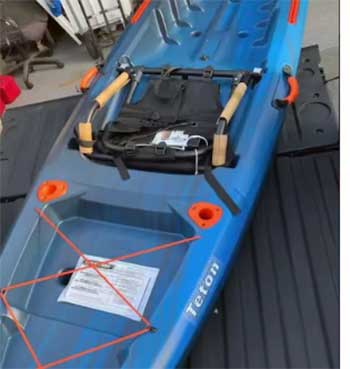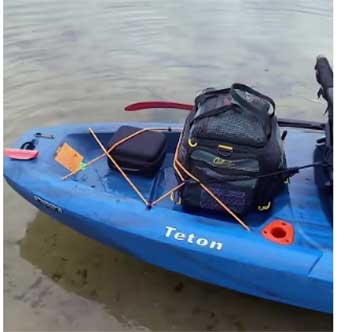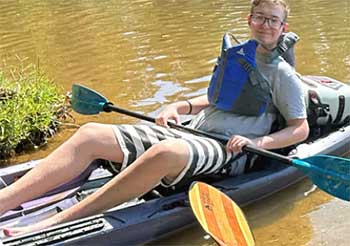Let me put it out there: if you’re itching for a kayak that’s stable, affordable, and ready to tackle your next adventure, the Quest Teton 100 is calling your name.
I’ve paddled it, loved it, and hauled it through enough trips to know it’s a gem for beginners and casual anglers alike.
You don’t need to break the bank or wrestle with a beast to hit the water—this kayak’s got your back. Stick with me as I spill my story, weigh the wins and quirks, and toss in some upkeep tips. By the end, you’ll be itching to grab one—let’s paddle in!
My Adventure With The Quest Teton 100 Kayak

I still remember the day I decided to ditch my buddy’s clunky old kayak and get my own.
I’d been borrowing his beat-up relic for fishing trips, but it weighed a ton and wobbled like a drunk duck.
So, last spring—March 2024, to be exact—I snagged the Quest Teton 100 from Lifetime’s lineup.
It promised a compact 10-footer with fishing perks, and at under $500, I figured it was worth a shot.
When it arrived, I hauled it out of the box, grinning at the sleek green hull and rod holders that screamed “fish me.”
My first paddle was on a glassy lake just outside town. I tossed it on my truck’s roof rack—solo, no sweat, thanks to its 50-pound frame—and hit the water by noon. Shoving off, I felt the hull settle steady beneath me, no tippy vibes.
I’m no pro, but I paddled out, dropped a line, and let the skeg keep me tracking straight. Caught a decent bass within an hour—those rod holders made switching gear a breeze. The frame seat wasn’t plush, but it held me comfy for a few hours without my back screaming.
I even popped the hatch to stash my lunch—kept it dry despite a splashy retrieve.
Since then, I’ve taken it out a dozen times—lakes, slow rivers, even a windy coastal creek. It’s handled choppy waves decently for its size, though I’ve had to muscle it against currents.
Once, I flipped it goofing around—user error, not the kayak’s fault—and it righted easy, no damage. Sure, there’ve been hiccups: the seat’s padding thinned out quick, and storage is tight with my tackle overload.
But every trip, I’m stoked to paddle something that’s mine, fits my budget, and doesn’t fight me. Let’s unpack what makes it rock and where it wobbles—I’ve got plenty to share.
Also Reads : My Thoughts On Teton Mesa Tent
The Pros Of The Quest Teton 100 Kayak
I’ve got to give the Quest Teton 100 some serious props—it’s got tricks up its sleeve that make it a keeper. First off, stability’s a standout. I’m not exactly a lightweight—hovering around 180 pounds—and this kayak doesn’t flinch when I shift to cast or reel in a fighter. The wide hull and deep keel keep it planted, even when I’m leaning over to snag a snag. You’ll love how it shrugs off small waves; it’s forgiving enough for newbies figuring out their balance.
Affordability’s another win. I shelled out less than $500, and for a fishing kayak with rod holders, gear tracks, and a solid seat, that’s a steal. You’re not dumping cash on a fancy rig you’ll barely use—this is entry-level done right. It’s lightweight too—50 pounds means I can hoist it onto my truck solo, no cursing or hernia required. If you’re like me and hate wrestling gear, you’ll grin every time you load up.
The fishing setup’s a quiet hero. Two flush-mount rod holders and gear tracks let me rig it my way—rods stay secure, and I’ve clipped a fish finder on without fuss. That rear tankwell with bungees? Perfect for my cooler or tackle box, though I’ll warn you it’s not huge. You’ll fish smarter, not harder, with this layout. And tracking’s solid—the skeg cuts through calm water like a knife, keeping you on course without constant paddle fights.
Durability’s a bonus I didn’t expect. I’ve scraped it over rocks and dragged it up gravel banks—high-density polyethylene laughs it off. No cracks, just scuffs. Plus, the five-year warranty’s got my back; I’ve heard they swap parts fast if something busts. For a kayak that fits your wallet and your weekend, the Teton 100’s a champ.
The Cons Of The Quest Teton 100 Kayak

Let’s keep it real—the Quest Teton 100 isn’t perfect, and I’ve hit some bumps worth mentioning.
Storage is a squeeze. That tankwell’s handy, but I’ve got a tackle obsession, and it fills up fast—my cooler barely fits with extra gear.
You’ll need to pack light or get creative, ‘cause there’s no sprawling cargo space here. The front hatch helps, but it’s small—don’t expect to stash a full picnic.
The seat’s a letdown over time.
First trip, it felt fine—adjustable backrest, decent support. But after a dozen outings, the padding’s flattened, and my tailbone’s grumbling after three hours. You might want to toss in a cushion; I’ve started hauling one, and it’s a game-changer. Comfort’s key if you’re out all day, and this skimps long-term.
Speed’s not its forte either. That wide hull keeps me steady, but it’s no racer—I’ve felt the drag paddling against wind or current. You’ll get where you’re going, but don’t expect to zip past anyone. And standing? Forget it. I tried once, nearly swam for it—the deck’s not built for that, no reinforcement. If you’re dreaming of stand-up fishing, this ain’t your boat.
Warranty’s great, but customer service can lag. A buddy had a cracked paddle holder—took three weeks and some nagging to get a replacement. My experience was smooth, but it’s a roll of the dice. And capacity’s tight—275 pounds sounds decent, but with my weight and gear, I’m pushing it. You’ll need to watch the load if you’re bigger or pack heavy. It’s solid, not flawless—know the trade-offs.
Also Reads : My Thoughts On Teton Mesa Tent
Maintenance Tips For The Quest Teton 100 Kayak
Keeping my Quest Teton 100 in shape’s been pretty straightforward, but I’ve picked up some hacks to make it last. Here’s what keeps it paddling strong.
Rinse It Down
After every trip—especially salty coastal runs—I hose it off. Mud, sand, fish slime—they’ll chew at the hull if you let ‘em sit. I hit the rod holders and tracks too; grit jams them up otherwise. You’ll keep it looking new and moving smooth with a quick rinse.
Dry It Right
I flipped it once and left it wet in the garage—next time, it smelled like a swamp. Now, I prop it upside down on sawhorses after washing, let it air out overnight. No sun baking—UV fades the plastic. You’ll dodge mold and keep the color popping this way.
Check the Skeg
That skeg’s a tracking champ, but rocks love it. I eyeball it monthly—once found a nick after a shallow scrape. Filed it smooth with sandpaper, no biggie. You’ll want to peek at yours; a bent one throws off your line.
Lube the Hatches
The front hatch started sticking after a sandy trip—annoying as hell. I hit the rubber seal with a silicone spray every few months now, keeps it popping open easy. You’ll save swearing time with a quick spritz; don’t let it seize up.
Store It Smart
I keep mine off the ground—hanging on straps in the garage. Flat storage warps the hull over time, especially loaded. You’ll extend its life keeping it suspended or tilted; no dents, no stress cracks.
These moves keep my kayak ready without much fuss. You’ll find it’s low-effort stuff that pays off—more paddling, less fixing.
Comparing The Quest Teton 100 Kayak To Other Brands
I’ve poked around, swapped tales with paddlers, and sized up the Quest Teton 100 against the crowd. Here’s how it holds water.
Quest Teton 100 Vs. Pelican Argo 100X
Pelican’s Argo 100X is a lightweight rival—36 pounds to the Teton’s 50. My pal swears by its easy carry, and the padded seat beats my flattened one for comfort. But fishing? Teton’s rod holders and tracks smoke it—Argo’s bare-bones there. Pelican’s cheaper—$320ish—but you’ll miss the angling perks. I’d pick Teton for fish over Argo’s chill paddle vibe.
Quest Teton 100 Vs. Lifetime Tamarack Angler
Lifetime’s Tamarack Angler’s a sibling—same maker, different flavor. It’s got a flatter deck, better for standing if you dare, and a bit more storage. I tried one; felt roomier for gear. But it’s heavier—52 pounds—and pricier at $550ish. Teton’s lighter and tracks straighter—I’d stick with it for simplicity over Tamarack’s extras.
Quest Teton 100 Vs. Perception Pescador 10
Perception’s Pescador 10 is a step up—$600, but pro-grade. A buddy’s got one; it’s faster, with a slick hull, and the seat’s plush for hours. Storage’s bigger too. Teton’s scrappier—less speed, less space—but half the cost. I’d take Teton for budget wins over Pescador’s premium polish.
Quest Teton 100 Vs. Old Town Vapor 10
Old Town’s Vapor 10 is a classic—$500ish, 47 pounds. My cousin loves its glide and cockpit comfort—beats Teton for long hauls. No rod holders stock, though; it’s more rec than fish. Teton’s got the angling edge and price—I’d roll with it over Vapor’s smoother but pricier ride.
The Teton 100’s not the fastest or fanciest, but it’s my pick for value, stability, and fishing grit. You’ll see where it fits your waves—it’s a contender worth eyeing.
Frequently Asked Questions (FAQ)
Lifetime Products churns out the Quest Teton 100—Utah-based, been at it since the ‘80s. They’re big on affordable outdoor gear, and this kayak’s part of their fishing push. I’ve got no beef with the build—solid for the price.
It’s rated at 275 pounds. I’m 180, toss in 50 pounds of gear—cooler, tackle, paddle—and it’s near the edge but holds. You’ll want to keep it under if you’re bigger or hauling heavy; it’ll sit low otherwise.
Five years, limited. Covers the hull and parts if they crap out—not abuse, though. I’ve heard they’re quick with claims—buddy got a new holder fast. You’re covered decently for a budget boat.
Conclusion

After a year paddling the Quest Teton 100, I’m all in—and you should be too.
It’s stable, cheap, and fishes like a champ, even if storage’s tight and the seat fades fast.
For under $500, you’re getting a lightweight rig that shrugs off scrapes and keeps you on the water, not the shore.
I grin every time I shove off, and I’d bet you’ll love the freedom it brings.
Don’t sleep on this—grab one now and paddle into your next adventure!
